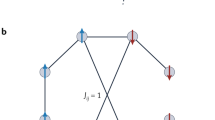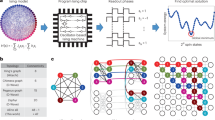Abstract
Ising machines are hardware devices that can solve ground-state search problems of Ising spin models and could be of use in solving various practical combinatorial optimization problems. However, large-scale systems have to be implemented by partitioning into subsystems that are hard to synchronize and where communication between them is difficult. Here, we report a scale-out architecture for Ising machines that provides enlarged machine sizes and enhanced processing speeds by using multiple connected chips. The architecture is based on the partitioned version of a quantum-inspired algorithm called simulated bifurcation. To maintain time consistency between multiple chips and a sufficiently small stall rate for every time-evolution step in simulated bifurcation, the architecture relies on an autonomous synchronization mechanism that is implemented in the information exchange processes between neighbouring chips and leads to scalability of computational throughput. Our eight-FPGA (field-programmable gate array) simulated bifurcation machine can obtain high-quality solutions to a 16,384-node MAX-CUT problem in 1.2 ms, which is 828 times faster than an optimized implementation of simulated annealing.
This is a preview of subscription content, access via your institution
Access options
Access Nature and 54 other Nature Portfolio journals
Get Nature+, our best-value online-access subscription
$29.99 / 30 days
cancel any time
Subscribe to this journal
Receive 12 digital issues and online access to articles
$119.00 per year
only $9.92 per issue
Buy this article
- Purchase on Springer Link
- Instant access to full article PDF
Prices may be subject to local taxes which are calculated during checkout





Similar content being viewed by others
Data availability
The data that support the plots within this paper and other findings of this study are available from the corresponding author upon reasonable request.
Code availability
The cluster simulator used in this work is available from the corresponding author upon reasonable request.
Change history
27 July 2021
A Correction to this paper has been published: https://doi.org/10.1038/s41928-021-00637-2
References
Soon, W. & Ye, H. Q. Currency arbitrage detection using a binary integer programming model. Int. J. Math. Educ. Sci. Technol. 42, 369–376 (2011).
Tatsumura, K., Hidaka, R., Yamasaki. M., Sakai, Y. & Goto, H. A currency arbitrage machine based on the simulated bifurcation algorithm for ultrafast detection of optimal opportunity. In Proc. IEEE International Symposium on Circuits and Systems (ISCAS) 1–5 (IEEE, 2020).
Hernandez, M. & Aramon, M. Enhancing quantum annealing performance for the molecular similarity problem. Quantum Inf. Process. 16, 133 (2017).
Li, R. Y., Di Felice, R., Rohs, R. & Lidar, D. A. Quantum annealing versus classical machine learning applied to a simplified computational biology problem. npj Quantum Inf. 4, 14 (2018).
Perdomo-Ortiz, A., Dickson, N., Drew-Brook, M., Rose, G. & Aspuru-Guzik, A. Finding low-energy conformations of lattice protein models by quantum annealing. Sci. Rep. 2, 571 (2012).
Sakaguchi, H. et al. Boltzmann sampling by degenerate optical parametric oscillator network for structure-based virtual screening. Entropy 18, 365 (2016).
Kanamaru, S. et al. Efficient ising model mapping to solving slot placement problem. In Proc. IEEE International Conference on Consumer Electronics (ICCE) 1–6 (IEEE, 2019).
Boyda, E. et al. Deploying a quantum annealing processor to detect tree cover in aerial imagery of California. PLoS ONE 12, e0172505 (2017).
Kirkpatrick, S., Gelatt, C. D. & Vecchi, M. P. Optimization by simulated annealing. Science 220, 671–680 (1983).
Barahona, F. On the computational complexity of Ising spin glass models. J. Phys. A 15, 3241–3253 (1982).
Lucas, A. Ising formulations of many NP problems. Front. Phys. 2, 5 (2014).
Johnson, M. W. et al. Quantum annealing with manufactured spins. Nature 473, 194–198 (2011).
Maezawa, M. et al. Toward practical-scale quantum annealing machine for prime factoring. J. Phys. Soc. Jpn 88, 061012 (2019).
Yoshimura, C., Hayashi, M., Okuyama, T. & Yamaoka, M. Implementation and evaluation of FPGA-based annealing processor for Ising model by use of resource sharing. Int. J. Netw. Comput. 7, 154–172 (2017).
Takemoto, T., Hayashi, M., Yoshimura, C. & Yamaoka, M. A 2 × 30k-spin multi-chip scalable CMOS annealing processor based on a processing-in-memory approach for solving large-scale combinatorial optimization problems. IEEE J. Solid State Circuits 55, 145–156 (2019).
Yamamoto, K., Ikebe, M., Asai, T., Motomura, M. & Takamaeda-Yamazaki, S. FPGA-based annealing processor with time-division multiplexing. IEICE Trans. Inf. Syst. E102.D, 2295–2305 (2019).
McMahon, P. L. et al. A fully programmable 100-spin coherent Ising machine with all-to-all connections. Science 354, 614–617 (2016).
Inagaki, T. et al. A coherent Ising machine for 2,000-node optimization problems. Science 354, 603–606 (2016).
Pierangeli, D., Marcucci, G. & Conti, C. Large-scale photonic Ising machine by spatial light modulation. Phys. Rev. Lett. 122, 213902 (2019).
Pierangeli, D., Rafayelyan, M., Conti, C. & Gigan, S. Scalable spin-glass optical simulator. Preprint at https://arxiv.org/abs/2006.00828 (2020).
Pierangeli, D., Marcucci, G. & Conti, C. Adiabatic evolution on a spatial-photonic Ising machine. Optica 7, 1535–1543 (2020).
Tsukamoto, S., Takatsu, M., Matsubara, S. & Tamura, H. An accelerator architecture for combinatorial optimization problems. Fujitsu Sci. Technol. J. 53, 8–13 (2017).
Isakov, S. V., Zintchenko, I. N., Rønnow, T. F. & Troyer, M. Optimised simulated annealing for Ising spin glasses. Comput. Phys. Commun. 192, 265–271 (2015).
Hamerly, R. et al. Experimental investigation of performance differences between coherent Ising machines and a quantum annealer. Sci. Adv. 5, eaau0823 (2019).
Goto, H., Tatsumura, K. & Dixon, A. R. Combinatorial optimization by simulating adiabatic bifurcations in nonlinear Hamiltonian systems. Sci. Adv. 5, eaav2372 (2019).
Goto, H. Bifurcation-based adiabatic quantum computation with a nonlinear oscillator network. Sci. Rep. 6, 21686 (2016).
Goto, H. Quantum computation based on quantum adiabatic bifurcations of Kerr-nonlinear parametric oscillators. J. Phys. Soc. Jpn 88, 061015 (2019).
Bello, L., Strinati, M. C., DallaTorre, E. G. & Pe’er, A. Persistent coherent beating in coupled parametric oscillators. Phys. Rev. Let. 123, 083901 (2019).
Strinati, M. C., Bello, L., Pe’er, A. & DallaTorre, E. G. Theory of coupled parametric oscillators beyond coupled Ising spins. Phys. Rev. A 100, 023835 (2019).
Strinati, M. C. et al. Coherent dynamics in frustrated coupled parametric oscillators. New J. Phys. 22, 085005 (2020).
Tatsumura, K., Dixon, A. R. & Goto, H. FPGA-based simulated bifurcation machine. In Proc. IEEE International Conference on Field-Programmable Logic and Applications (FPL) 59–66 (IEEE, 2019).
Hennessy, J. L. & Patterson, D. A. in Computer Architecture: A Quantitative Approach 6th edn, Appendix I (Elsevier, 2017).
Del Sozzo, E., Rabozzi, M., Di Tucci, L., Sciuto, D. & Santambrogio, M. D. A scalable FPGA design for cloud n-body simulation. In Proc. IEEE International Conference on Application-Specific Systems, Architectures and Processors (ASAP) 1–8 (IEEE, 2018).
Huthmann, J., Shin, A. Podobas, A., Sano, K. & Takizawa, H. Scaling performance for N-body stream computation with a ring of FPGAs. In Proc. 10th International Symposium on Highly-Efficient Accelerators and Reconfigurable Technologies (HEART) 1–6 (2019).
Goemans, M. X. & Williamson, D. P. Improved approximation algorithms for maximum cut and satisfiability problems using semidefinite programming. J. ACM 42, 1115–1145 (1995).
Hopfield, J. J. Neural networks and physical systems with emergent collective computational abilities. Proc. Natl Acad. Sci. USA 79, 2554–2558 (1982).
Bianchi, F. M., Maiorino, E., Kampffmeyer, M. C., Rizzi, A. & Jenssen, R. Recurrent Neural Networks for Short-Term Load Forecasting: an Overview and Comparative Analysis (Springer, 2017).
Hopfield, J. J. & Tank, D. W. Computing with neural circuits: a model. Science 233, 625–633 (1986).
Arora, S. & Barak, B. Computational Complexity: A Modern Approach (Cambridge Univ. Press, 2009).
Acknowledgements
We thank Y. Kaneko, Y. Hikichi and Y. Kawamata for their support.
Author information
Authors and Affiliations
Contributions
K.T. and H.G. conceived the project. K.T. designed the cluster architecture. K.T. and M.Y. implemented the design with FPGAs and measured the performance. H.G. implemented and evaluated the optimized simulated annealing. K.T. analysed and evaluated the results. K.T. wrote the manuscript. All authors reviewed and edited the manuscript.
Corresponding author
Ethics declarations
Competing interests
K.T. and H.G. are inventors on two US patent applications related to this work filed by the Toshiba Corporation (no. 16/123146, filed 6 September 2018; no. 16/118646, filed 31 August 2018).
Additional information
Peer review information Nature Electronics thanks Claudio Conti, Kentaro Sano and the other, anonymous, reviewer(s) for their contribution to the peer review of this work.
Publisher’s note Springer Nature remains neutral with regard to jurisdictional claims in published maps and institutional affiliations.
Supplementary information
Supplementary Information
Supplementary Figs. 1–9 and Discussion.
Rights and permissions
About this article
Cite this article
Tatsumura, K., Yamasaki, M. & Goto, H. Scaling out Ising machines using a multi-chip architecture for simulated bifurcation. Nat Electron 4, 208–217 (2021). https://doi.org/10.1038/s41928-021-00546-4
Received:
Accepted:
Published:
Issue Date:
DOI: https://doi.org/10.1038/s41928-021-00546-4
This article is cited by
-
A CMOS-compatible oscillation-based VO2 Ising machine solver
Nature Communications (2024)
-
Point convolutional neural network algorithm for Ising model ground state research based on spring vibration
Scientific Reports (2024)
-
Energy-efficient superparamagnetic Ising machine and its application to traveling salesman problems
Nature Communications (2024)
-
Bifurcation behaviors shape how continuous physical dynamics solves discrete Ising optimization
Nature Communications (2023)
-
Highly reconfigurable oscillator-based Ising Machine through quasiperiodic modulation of coupling strength
Scientific Reports (2023)



